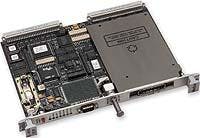Enabling technologies for military and aerospace electronics designers
Computer peripheralsLockheed Martin chooses ViaSat for U.S. Army information security cardOfficials at Lockheed Martin Corp. in Bethesda, Md., recently selected engineers at Via Sat Inc. to design and manufacture the information security card component for the U.S. Army Theater High Altitude Area Defense (THAAD) launcher. The Launcher Encryption Module is an extension of ViaSat's on-going Internet protocol (IP) based cryptographic modernization projects."As a Lockheed Martin Star Supplier, we are pleased to be teamed with them again," says Jerry Goodwin, Network Systems director for ViaSat. "The Launcher Encryption Module will provide the Army with the most modern cryptography in a small form factor that's rugged enough for the THAAD launcher's demanding environment. The features, performance, and versatility of the Launcher Encryption Module will provide a solution for the THAAD program and establish a framework for broader applications elsewhere in the Department of Defense community."
The ViaSat Internet Protocol Crypto (VIP Crypto) product family combines high-assurance cryptography with robust networking features to take advantage of the IP-based networks in transporting sensitive data, ViaSat officials say. VIP Crypto products are designed to provide Type 1 encryption for networked users, enabling them to securely pass IP data packets up to "Top Secret" across private intranets, wide area enterprises, or the public Internet, company officials say.
ViaSat produces advanced digital satellite telecommunications and wireless signal processing systems for commercial and government markets, ViaSat officials say. Other products include tactical communication radios, network security products, and RF communication simulators. ViaSat's full line of satellite communication products includes VSAT systems for network access and infrastructure, and Ka-band satellite systems, from user terminals to large gateways for geosynchronous and low earth orbit satellites. ViaSat also has divisions located in Clarksburg, Md., and Norcross, Ga. Additional field offices are located in Boston, Mass., the United Kingdom, Australia, Chile, China, and India.
For more information on ViaSat's security technology contact the company by phone at 760-476-2200, by fax at 760-929-3941, by post at 6155 El Camino Real, Carlsbad, Calif. 92009-1699, or on the World Wide Web at http://www.viasat.com.
Design & development toolsDelphi chooses antenna design and validation tool from MI TechnologiesSystems designers at Delphi Corp. in Troy, Mich., needed an antenna test and measurement system to help them design, develop, and validate a wide range of automotive antennas. The Futba Reception Systems from MI Technologies in Duluth, Ga., met their needs.Delphi experts will use the MI Technologies Futba Reception Systems to test antennas for AM and FM radio signals, television reception, global cell phone frequencies, global positioning satellite systems in on-board navigation systems, and satellite digital audio radio reception systems that operate in the 2 to 3 GHz frequency range, company officials say.
MI Technologies will install the outdoor test and measurement system at the Delphi Technical Center in Brighton, Mich., which is to be operational in September.
The new system will have the MI-7121 24-foot tunable to rotate vehicles under test, an MI-7141 gantry to position the source antenna above the vehicle for near-field measurements, an MI-7131 transmit antenna mast for positioning the far-field source antenna, and an MI-3001 data acquisition and analysis workstation to measure antennas and generate reports.
For more information contact MI Technologies by phone at 678-475-8338, by post at 4500 River Green Parkway, Suite 200, Duluth, Ga. 30096, by e-mail at [email protected], or on the World Wide Web at http://www.mi-technologies.com/.
ComputersVexcel to provide synthetic aperture radar processing for ENVIASAT satellite dataScientists at the NASA Earth Observing System program office at the NASA Goddard Research Center in Greenbelt, Md., needed a synthetic aperture radar (SAR) processing system for the Alaska SAR Facility. The ENVIASAT/ASAR processing system from Vexcel Corp. of Boulder, Colo., met their needs.Vexcel's new system will process data from the recently launched ENVIASAT satellite, which officials of the European Space Agency claim is the largest and most sophisticated Earth observation satellite.
Vexcel engineers designed the ENVIASAT/ASAR processing system to process data from raw telemetry to high-level data products, company officials say.
The system for the Alaska SAR Facility includes level-zero processing, which provides the initial processing of raw data; a quick-viewing function; and primary processing for the 60-mile-wide ENVIASAT/ASAR swath.
Optional system capabilities include radar stereo and interferometric SAR processing to create digital elevation models and orthorectification processing for precise image processing.
For more information contact Vexcel by phone at 303-444-0094, by fax at 303-444-0470, by post at 4909 Nautilus Court, Boulder, Colo. 80301, or on the World Wide Web at http://www.vexcel.com/.
Board productsLockheed Martin picks Sky's computer systems for weather radar test bed programRadar designers at the Lockheed Martin Naval Electronics and Surveillance Systems Surface Systems division in Moorestown, N.J., needed powerful computers for the National Weather Radar Test bed program. Experts at Sky Computers in Chelmsford, Mass., met their needs.Lockheed Martin officials are purchasing two multiprocessing computers from Sky that run as fast as 32 billion floating point operations per second (gigaFLOPS), and at 256 gigaFLOPS.
The first phase of the weather radar test bed will conduct weather research with the rapid-scanning capabilities of a phased-array radar system.
The test bed is a collaborative effort of the U.S. Office of Naval Research, the National Oceanic and Atmospheric Administration's National Severe Storms Laboratory, the National Weather Service, the University of Oklahoma, and the Federal Aviation Administration's William J. Hughes Technical Center.
The test bed, which uses technology developed originally for U.S. Navy Ticonderoga-class cruisers and Arleigh Burke-class destroyers, relies on phased-array radar and advanced signal-processing techniques to improve the warning time for tornados and other dangerous weather conditions.
For more information contact Sky Computers by phone at 978-250-1920, by fax at 978-250-0036, by post at 27 Industrial Ave., Chelmsford, Mass. 01874, or on the World Wide Web at http://www.skycomputers.com/.
ComponentsOCCAR chooses avionics from EADS for the Franco-German Tiger combat helicopterProcurement officials from the Organisation for Joint Armament Co-operation (OCCAR) in Bonn, Germany, needed avionics for the Franco-German Tiger combat helicopter. The EuroGrid digital map system from Dornier GmbH in Friedrichshafen, Germany, met their needs.Dornier engineers are working under terms of a contract worth 50 million euros to equip 160 Tiger helicopters with the EuroGrid digital map system. Dornier is part of the European Aeronautic Defense and Space Co., better known as EADS.
The governments of France and Germany are to buy about 400 Tiger helicopters. EuroGrid is scheduled for use on all Tiger aircraft, as well as for the NH90 helicopters of Germany, France, Italy, and the Netherlands, Dornier officials say.
EuroGrid displays colored topographic terrain maps, which move simultaneously with the flight of the helicopter. Maps appear on two independent multifunction displays aboard the Tiger, which shows maps in different scales with overlays of graphic information.
The avionics help helicopter crew members navigate, communicate, and plan flights and tactics.
For more information contact Dornier GmbH by phone at 011-49-7545-891-24, by fax at 011-49-7545-858-88, by e-mail at [email protected], or on the World Wide Web at http://www.dasa.de/.
Power electronicsSmiths chooses Tyco to provide electronic distribution unit on JSFAvionics designers at Smiths Industries in Cheltenham, England, needed power relays, power buses, connectors, and backplanes for the future U.S. F-35 Joint Strike Fighter (JSF). The High Power Electronic Distribution Unit from Tyco Electronics in Harrisburg, Pa., met their needs.Under terms of the contract, Tyco experts will provide four 270-volt DC power relays, power busing, power connectors, and power backplanes to accept Smiths Industries electronic sensing and control boards aboard the future JSF. Smiths is under contract to Lockheed Martin in Fort Worth, Texas, to design and develop the electrical power management system for the JSF.
Tyco designers will use Kilovac-brand products with special sealed contact features, which went to Tyco in the company's recent acquisition of CII Technologies.
"High-voltage DC power systems are relatively new to the aerospace industry, and are being used because of the demand for mower power with less weight," explains Mike Molyneux, director of engineering at the High Performance Relay Group of Tyco Electronics.
For more information contact Don McGowan at Tyco Electronics power relays group by phone at 419-524-1411, ext 532, or Pat McPherson by phone at 805-684-4560, ext. 103, by e-mail at [email protected], or on the World Wide Web at http://relays.tycoelectronics.com/.
ComponentsViaSat to provide antennas for range safety systemOfficials at Honeywell Space Systems recently chose ViaSat Satellite Ground Systems in Norcross, Ga., to provide the range safety system (RSS) for the Alaska Aerospace Development Corp. (AADC) Kodiak Launch Complex.The RSS, which will use four ViaSat mobile S-Band Tracking and Telemetry/UHF-Band Command Destruct integrated antenna systems, tracks launch vehicle data, and provides ground controllers with the ability to terminate the flight should problems arise, ViaSat officials say.
The Kodiak location launches all types of commercial launch vehicles and military rockets, company officials say. The AADC requires range data and command control equipment to provide real time information to range users and to perform range safety operations. The primary responsibility of the RSS is to provide positive control of the launch vehicle for public safety.
These tracking and telemetry systems combine the ability to receive an S-band telemetry data signal with the ability to transmit high-power UHF Command Destruct tones, ViaSat officials say. Each of the four antenna systems consists of a 5.4-meter reflector, elevation over azimuth pedestal, and a specialized Telemetry Tracking/UHF feed. The complete system includes a trailer/mounting base that provides full roadworthy towing as well as a stable tracking platform.
The AADC was established in 1991 to develop Alaska based economic and technical opportunities in the aerospace industry, ViaSat officials say. The Kodiak Launch Complex is a dual use spaceport for commercial and government vehicles for sub-orbital and orbital trajectories over a wide range of launch azimuths. The missions being flown from this spaceport cover a range from remote sensing and communications to missile-defense technology demonstrators and testing.
For more information on ViaSat's security technology contact the company by phone at 760-476-2200, by fax at 760-929-3941, by post at 6155 El Camino Real, Carlsbad, Calif. 92009-1699, or on the World Wide Web at http://www.viasat.com.
SoftwareRockwell Collins Flight Dynamics uses Engenuity tool to help certify under DO-178BOfficials at Rockwell Collins Flight Dynamics recently selected the Qualifiable Code Generator (QCG) software development tool from Engenuity Technologies in Montreal, in an effort to certify future military avionics applications under the Federal Aviation Administration's (FAA) RTCA DO-178B regulations.Software deployed in military and commercial aircraft today requires 100 percent reliability for the sake of the passengers' and crewmembers' lives that depend on the error-free functionality, Engenuity Technologies officials say. The FAA has published stringent guidelines on how qualifiable development software is to be developed, verified, and certified by such companies, company officials say.
DO-178B - and its counterpart ED-12B in Europe - was developed through the cooperative efforts of RTCA (the Radio Technical Commission for Aeronautics) and the European Organization for Civil Aviation Equipment (EUROCAE). DO-178B provides guidelines for the software development process yet is not a development standard or process document. Software developers may use any development methodology as long as the criteria in DO-178B are satisfied in the areas of planning, software development (requirements definition, design, code, integration, and verification), configuration management, and quality assurance.
DO-178B recognizes that different applications and systems have different potential for failure. Accordingly, five software levels (A through E) have been defined for the effort required to show certification compliance in accordance with the different hazard classifications. The effort required for each level is on a sliding scale with the Level A, the most safety-critical, requiring the most scrutiny and Level E, the least critical, requiring the least scrutiny. As defined in DO-178B, failure or anomalous behavior of Level-A software could have a catastrophic effect for an aircraft, while Level B is for software that could have a hazardous or severe-major effect. Levels C and D have to do with major and minor effects, respectively, and Level E with software that would have no effect.
Engenuity Technology officials claim that their QCG software is the first embedded graphics development tool to be produced under RTCA DO-178B regulations and delivered as a qualifiable development tool. The software provides a solution to meet these requirements and significantly reduces the time and cost involved to develop software applications, company officials claim.
The QCG is an enhanced code generation tool to be used in conjunction with its existing VAPS tools, Engenuity officials say. It also includes a certification kit that includes all of the necessary data from the tool's development cycle to enable the tool to be qualifiable on a given application, company officials say.
For more information on QCG and Engenuity Technologies contact the company by phone at 514-341-3874, by fax at 514-341-8018, by post at 4700 de la Savane, Suite 300, Montreal, Quebec, Canada H4P 1T7, or on the World Wide Web at http://www.engenuitytech.com/.
Communications equipmentTaiwan's armed forces choose CMC radios for voice, data, and video communicationsOfficials of the Procurement Bureau of the Taiwanese Ministry of National Defense in Taipei, Taiwan, needed combat radios for the Taiwanese armed forces. The AN/GRC-245 high-capacity line-of-sight radio from CMC Electronics in Ville Saint-Laurent, Quebec, met their needs.CMC is working under terms of contract worth 5.9 million Canadian dollars to provide the AN/GRC-245 to Taiwanese armed forces. Engineers from the Chunk Shan Institute of Science and Technology in Taiwan will integrate the CMC radios into a point-to-point radio relay system for voice, data, and video.
The GRC-245 provides as much as "8 megabits per second capacity to meet the growing requirements for situation awareness data and video conferencing," says Alan Barker, CMC's vice president of military communications. "Its spectrum efficiency and range were significant factors in the competitive evaluation."
CMC is delivering GRC-245 radio to the U.S. Army under the Area Common User System Radio Modernization program, which CMC won in 1988. This radio also is part of the Cormorant project for the United Kingdom's Rapid Reaction Forces. The contract with Taiwan is CMC's first radio sale in Asia.
For more information contact CMC Electronics by phone at 514-748-3148, by fax at 514-748-3100, by post at 600 Dr. Frederik Phillips Blvd., Ville Saint-Laurent, Quebec, Canada, H4M 2S9, or on the World Wide Web at http://www.cmcelectronics.ca/.




